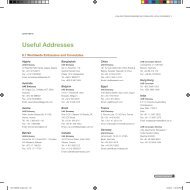Arab World Competitiveness Report 2011-2012 - World Economic ...
Arab World Competitiveness Report 2011-2012 - World Economic ...
Arab World Competitiveness Report 2011-2012 - World Economic ...
You also want an ePaper? Increase the reach of your titles
YUMPU automatically turns print PDFs into web optimized ePapers that Google loves.
1. A Time of Opportunities: The <strong>Competitiveness</strong> Performance of the <strong>Arab</strong> <strong>World</strong><br />
<strong>Arab</strong> <strong>World</strong> <strong>Competitiveness</strong> <strong>Report</strong> <strong>2011</strong>-<strong>2012</strong><br />
A total of 14 <strong>Arab</strong> countries have been added to the<br />
sample of economies covered by the GCI over the<br />
past decade. Presently, the Index captures Algeria,<br />
Bahrain, Egypt, Jordan, Lebanon, Morocco, Kuwait,<br />
Oman, Qatar, Saudi <strong>Arab</strong>ia, Syria, Tunisia, United <strong>Arab</strong><br />
Emirates, and Yemen. Libya, which has been included<br />
in past editions of the GCI, was excluded this year<br />
because it was not possible to carry out the survey<br />
during the civil unrest in the country. Table 1 shows<br />
how countries in the <strong>Arab</strong> <strong>World</strong> are allocated into the<br />
three stages and provides details about the weighting<br />
scheme.<br />
It is important to note that the GCI is calculated using<br />
two distinct types of data. Data for approximately<br />
one-third of the indicators are obtained mainly from<br />
major international organizations, such as the <strong>World</strong><br />
Bank, International Monetary Fund, UNESCO, and<br />
so on. For the remaining indicators, data are derived<br />
from the <strong>World</strong> <strong>Economic</strong> Forum’s annual Executive<br />
Opinion Survey. By surveying business executives, it<br />
provides an assessment of the more qualitative aspects<br />
of competitiveness, as well as of dimensions for which<br />
statistical sources are not available for all countries<br />
covered by the GCI. The Survey is conducted in<br />
collaboration with partner institutions in each country,<br />
which administer the survey process. In <strong>2011</strong>, over<br />
14,000 business executives were surveyed in 142<br />
countries between January and May. 3<br />
Since 2007, the Survey data have been calculated as<br />
a moving average of the present and the previous year,<br />
in line with a Bayesian updating approach. There are<br />
several reasons for doing so. First, it renders the results<br />
less sensitive to the specific point in time when the<br />
survey is administered. Second, it increases the amount<br />
of available information by providing a larger sample<br />
size and by retaining some previous information that<br />
continues to be deemed valuable. Additionally, because<br />
the Survey is carried out during the first quarter of the<br />
year, averaging the responses from the first quarter<br />
of 2010 and the first quarter of <strong>2011</strong> better aligns the<br />
survey data with many of the data indicators from<br />
sources other than the Forum, which are often yearaverage<br />
data.<br />
14<br />
Table 1: <strong>Arab</strong> world economies by stage of development<br />
Stage 1 (factor-driven)<br />
GDP per capita (US$) < 2,000;<br />
Transition from 1 to 2<br />
2,000< GDP per capita (US$) < 3,000;<br />
Stage 2 (efficiency-driven)<br />
3,000 < GDP per capita (US$) < 9,000;<br />
Transition from 2 to 3<br />
9,000< GDP per capita (US$) < 17,000;<br />
Stage 3 (innovation-driven)<br />
GDP per capita (US$) > 17,000;<br />
<strong>Arab</strong> world Other countries in this stage Important areas for<br />
competitiveness<br />
Yemen<br />
Algeria, Egypt, Kuwait, Morocco,<br />
Qatar, Saudi <strong>Arab</strong>ia, Syria<br />
Jordan, Lebanon, Tunisia<br />
Oman<br />
Bahrain, United <strong>Arab</strong> Emirates<br />
Bangladesh, Bolivia, Kenya,<br />
Pakistan, Vietnam<br />
Brunei Darussalam, Indonesia,<br />
Iran, Islamic Rep., Ukraine,<br />
Venezuela, Argentina, Brazil,<br />
China, Malaysia,<br />
Mexico, Russian Federation,<br />
South, Africa, Turkey<br />
Chile, Croatia, Poland, Trinidad<br />
and Tobago<br />
Germany, Korea, Rep, Norway,<br />
Spain, United Kingdom, United<br />
States<br />
Basic requirements (60%) and<br />
efficiency enhancers (35%)<br />
Basic requirements (between<br />
40% and 60%) and efficiency<br />
enhancers (between 35% and<br />
50%)*<br />
Basic requirements (40%) and<br />
efficiency enhancers (50%)<br />
Basic requirements (between<br />
20% and 40%) and efficiency<br />
enhancers (50%) Innovation<br />
factors (10% to 30%)*<br />
Basic requirements (20%) and<br />
efficiency enhancers (50%)<br />
Innovation factors (30%)*<br />
Note: For countries with a share of mineral export in total exports higher than 70% are moved towards a lower stage of development. Source: Global<br />
<strong>Competitiveness</strong> <strong>Report</strong> <strong>2011</strong>- <strong>2012</strong>





